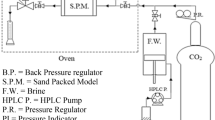Abstract
The relative permeability of CO2 and brine has a significant impact on CO2 saturation, migration, and injectivity for CO2 geological storage. This study presents a new experimental apparatus consisting of a double separator that can reduce uncertainties in measuring fluid saturation. It was applied to measure relative permeabilities of in-situ cores samples of Berea, Gorae, and Paaratte sandstone. The wettability criteria and Brook-Corey model were applied to explain the characteristics in relative permeability of CO2 and brine. The result for Berea sandstone using the developed apparatus was consistent with results obtained in literatures, and they indicate high residual brine saturation and low end-point relative permeability of CO2. The results for Gorae sandstone show that the residual brine saturation is higher and the shape of the relative permeability curves are more concave compared to those of Paaratte sandstone; these results relate to the water-wetting tendency and dominant capillary flow, respectively. It means that injection of CO2 into Gorae sandstone is expected to be less efficient than into Paaratte sandstone. Therefore, it is reasonable to estimate that less amount of CO2 should be injected into Gorae sandstone compared to Paaratte sandstone.
Similar content being viewed by others
References
Amaefule, J.O. and Handy, L.L., 1982, The effect of interfacial tensions on relative oil/water permeabilities of consolidated porous media. Society of Petroleum Engineers Journal, 22, 371–381. https://doi.org/10.2118/9783-PA
Bachu, S., 2003, Sequestration of CO2 in geological media in response to climate change: capacity of deep saline quifers to sequester CO2 in solution. Energy Conversion and Management, 44, 3151–3175. https://doi.org/10.1016/S0196-8904C03j00101-8
Bachu, S., Bonijoly, D., Bradshaw, J., Burruss, R., Holloway, S., Christensen, N.P., and Mathiassen, O.M., 2007, CO2 storage capacity estimation: methodology and gaps. International Journal Greenhouse Gas Control, 1, 430–443. https://doi.org/10.1016/S1750-5836(07)00086-2
Bennion, B. and Bachu, S., 2008, Drainage and imbibition relative permeability relationships for supercritical CO2/brine and H2S/brine systems in intergranular sandstone carbonate shale and anhydrite rocks. SPE Reservoir Evaluation & Engineering, 11, 487–496. https://doi.org/10.2118/99326-PA
Bradshaw, J., Bachu, S., Bonijoly, D., Burruss, R., Holloway, S., Christensen, N.P., and Mathiassen, O.M., 2007, CO2 storage capacity estimation: issues and development of standards. International Journal Greenhouse Gas Control, 1, 62–68. https://doi.org/10.1016/S1750-5836(07)00027-8
Brooks, R.H. and Corey, A.T., 1964, Hydraulic Properties of Porous Media. Hydrology Papers 3, Colorado State University, Fort Collins, 27 p.
Burton, M., Kumar, N., and Bryant, S., 2009, CO2 injectivity into brine aquifers: why relative permeability matters as much as absolute permeability. Energy Procedia, 1, 3091–3098. https://doi.org/10.1016/j.egypro.2009.02.089
Choi, B.Y., Shinn, Y.J., Park, Y.C., Park, J.Y., Kwon, Y.K., and Kim, K.Y., 2017, Simulation of CO2 injection in a small-scale pilot site in the Pohang Basin, Korea: effect of dissolution rate of chlorite on mineral trapping. International Journal Greenhouse Gas Control, 59, 1–12. https://doi.org/10.1016/j.ijggc.2017.02.001
CO2CRC Building a Low Emissions Future Web, 2018, http://www.co2crc.com.au/video/animations/[Accessed on 25 Nov 2019].
Craig, F.F., 1971, The Reservoir Engineering Aspects of Waterflooding. SPE Monograph Series Vol. 3, Richardson, 134 p.
Fulcher, R.A., Ertekin, T., and Stahl, C.D., 1985, Effect of capillary number and its constituents on two-phase relative permeability curves. Journal of Petroleum Technology, 37, 249–260. https://doi.org/10.2118/12170-PA
Honarpour, M.M., Koederitz, L., and Harvey, A.H., 1986, Relative Permeability of Petroleum Reservoirs. CRC Press, Boca Raton, 152 p.
IPCC (Intergovernmental Panel on Climate Change), 2005, IPCC Special Report on Carbon Dioxide Capture and Storage. Cambridge University Press, New York, 443 p.
Krevor, S.C.M., Pini, R., Zuo, L., and Benson, S.M., 2012, Relative permeability and trapping of CO2 and water in sandstone rocks at reservoir conditions. Water Resource Reserch, 48, W02532. https://doi.org/10.1029/2011WR010859
Lee, Y.S., Kim, K.H., Lee, T.H., Sung, W.M., and Lee, J.H., 2009, Analysis of CO2 endpoint relative permeability and injectivity by change in pressure, temperature, and phase in saline aquifer. Energy Sources, 32, 83–99. https://doi.org/10.1080/15567030903077337
McCain, W.D., 1991, Reservoir fluid property correlations-state of the art. SPE Reservoir Engineering, 6, 266–272. https://doi.org/10.2118/18571-PA
Moodie, N., Pan, F., Jia, W., and McPherson, B., 2017, Impacts of relative permeability formulation on forecasts of CO2 phase behavior, phase distribution, and trapping mechanisms in a geologic carbon storage reservoir. Greenhouse Gases Science and Technology, 7, 958–962. https://doi.org/10.1002/ghg.1610
Müller, N., 2010, Supercritical CO2-brine relative permeability experiments in reservoir rocks-literature review and recommendations. Transport in Porous Media, 87, 367–383. https://doi.org/10.1007/s11242-010-9689-2
National Institute for Standards and Technology (NIST) chemistry webbook, 2018, https://webbook.nist.gov/chemistry/fluid/ [Accessed on 25 Nov 2019].
Park, Y.C., Huh, D.G., Yoo, D.G., Hwang, S.H., Lee, H.Y., and Roh, E., 2009, A review of business model for CO2 geological storage project in Korea. Journal of the Geological Society of Korea, 45, 579–587.
Perrin, J.C. and Benson, S., 2010, An experimental study on the influence of sub-core scale heterogeneities on CO2 distribution in reservoir rocks. Transport in Porous Media, 82, 93–109. https://doi.org/10.1007/s11242-009-9426-x
Pini, R. and Benson, M., 2013, Simultaneous determination of capillary pressure and relative permeability curves from core-flooding experiments with various fluid pairs. Water Resources Research, 49, 3516–3530. https://doi.org/10.1002/wrcr.20274
Richardson, J.G., Kerver, J.K., Hafford, J.A., and Osoba, J.S., 1952, Laboratory determination of relative permeability. Journal of Petroleum Technology, 4, 3375–3385. https://doi.org/10.2118/952187-G
Shinn, Y.J., Yoo, D.G., Hwang, S.H., Park, Y.C., and Huh, D.G., 2012, A preliminary screening of CO2 geological storage in Ulleung Basin, Korea. Journal of the Korean Society of Mineral and Energy Resources Engineers, 49, 47–58.
Tatar, A., Shokrollahi, A., Lee, M., Kashiwao, T., and Bahadori, 2015, Prediction of supercritical CO2/brine relative permeability in sedimentary basins during carbon dioxide sequestration. Greenhouse Gases Science and Technology, 5, 958–962. https://doi.org/10.1002/ghg.1524
Acknowledgments
This research was supported by a grant from the Energy Efficiency & Resources of the Korea Institute of Energy Technology Evaluation and Planning (KETEP) (No. 20162010201980).
Author information
Authors and Affiliations
Corresponding author
Additional information
Publisher’s Note
Springer Nature remains neutral with regard to jurisdictional claims in published maps and institutional affiliations.
Rights and permissions
About this article
Cite this article
Jeong, G.S., Choi, J., Lee, D.S. et al. Analysis of CO2 and brine relative permeability of in-situ core samples with employing double separator. Geosci J 25, 363–371 (2021). https://doi.org/10.1007/s12303-020-0027-6
Received:
Accepted:
Published:
Issue Date:
DOI: https://doi.org/10.1007/s12303-020-0027-6




